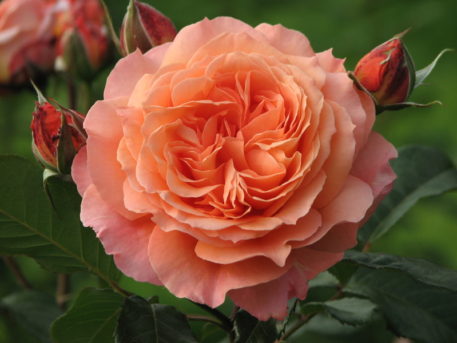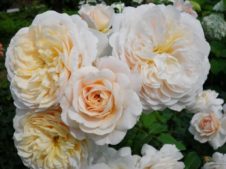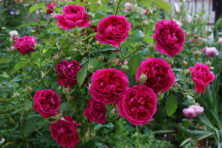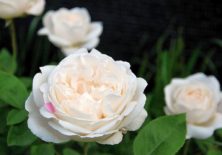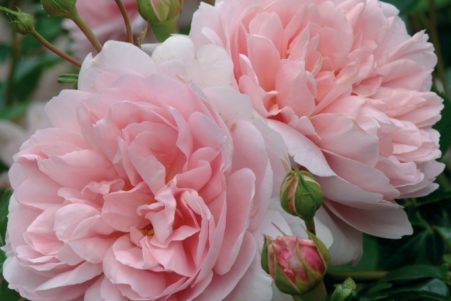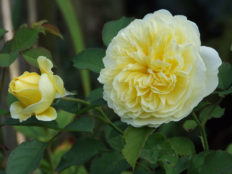Having embodied all the best from old and modern varieties, the English rose won the well-deserved sympathies of gardeners. Large flowers with a pleasant aroma, resistance to diseases, long and abundant flowering - these advantages make her a desirable inhabitant of rose gardens.
Material Content:
Description and features of varieties
The authorship of the creation of a group of varieties, united under the common name "English Rose", belongs to David Austin, a famous English breeder. Most subspecies of this group belong to semi-flat forms or tall shrubs.
Description of varieties of English roses:
- Falstaff - the height of the bush reaches one and a half meters, during flowering it is all covered with large flowers of amazing beauty. The Falstaff variety is considered one of the most beautiful - purple flowers are initially bright, and, when burned, they acquire purple-purple iridescent shades.
- Abraham Darby - the bush is large and sprawling, about 1.5 m high, can grow up to 2.5 m with good care. It does not tolerate shade and even partial shade, blooms profusely all summer only in a well-lit place. Flowers are peachy pink, buds are pale pink, exude a delicate fruity aroma.
- Benjamin Britten - forms a very powerful sprawling bush about 120–165 cm in size. The flowers are bright raspberry, have a delicate fruity aroma with citrus notes. The variety was bred in 2001.
- Charlotte - Bushes are powerful, branched, more than 185 cm high. Strong-double flowers burn out in the sun, painted in various shades of yellow, with a lemon center and cream edges. During flowering, a strong aroma of tea roses exude. The variety was created in 1994.
All English roses are distinguished by repeated flowering, pleasant aroma, beautiful shape and color of flowers. They are resistant to fungal diseases and frost, prefer bright sun. But there are also shade-tolerant varieties: Crocus Rose, Gertrude Jekull, Golden Celebration, Queen of Sweden, etc.
Preparing and planting an English rose
The English rose seedlings bought in the nursery must have a quality certificate, then you can be sure that they are original.
English roses are preferably planted at a distance of 1 m from each other, because the bushes grow powerful, sprawling. The composition of the soil is important, so as not to be disappointed as a result, it is advisable to carry out preparatory work before planting - digging the site, adding organic matter.
They plant roses in a place where there is no stagnation of water in the spring. Groundwater located close to the surface is a big problem. They can destroy the root system. The exit will be landing on a hill.
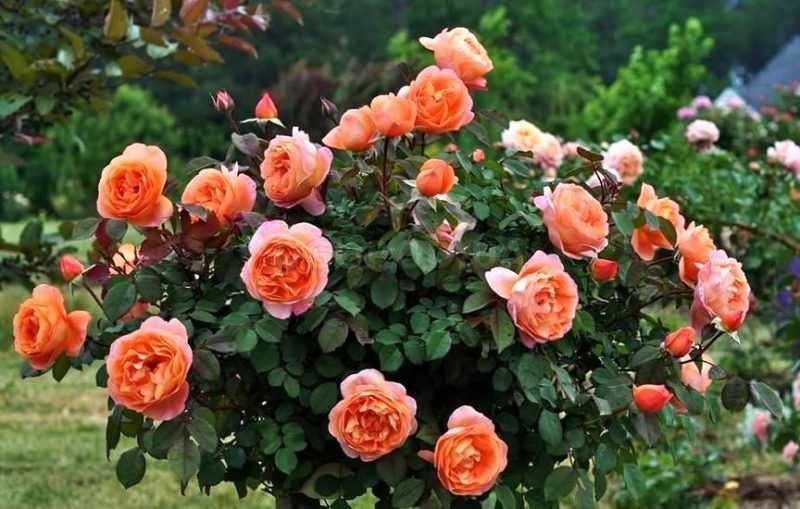
Description of the landing process:
- Before planting, a rose with an open root system is soaked for 12 hours. A clay chatter will come off the roots, and then they need to be trimmed a little.
- Dig a hole on 2 bayonet shovels, laying the nutrient layer to the side.
- Compost, humus or vermicompost (about 1 kg) is placed at the bottom of the recess. During spring planting of seedlings, you can also add mineral fertilizer - nitroammofosku (20-30 g). All dressings are mixed in the hole with the ground.
- Having placed a sapling in a hole, straighten the roots, and then cover it with earth.
- The place of grafting roses is buried in the soil by 10 cm.
- Then the hole is watered, it is covered with dry earth, and water is again added.
From above, the seedling should be covered with a plastic 5-liter bottle without a bottom, and shaded with a thin agrofiber.
The nuances of cultivation and care
In addition to the usual watering for all roses, loosening the soil and seasonal pruning, the care and cultivation of an English beauty has its own characteristics.
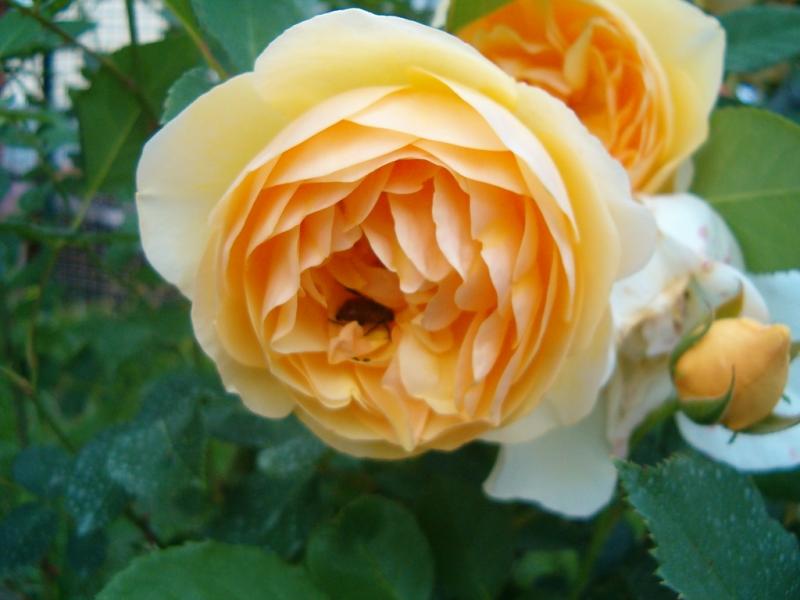
To avoid drooping shoots, plants need to be fed with the right trace elements. For this, fertilizers containing phosphorus and potassium are used. To strengthen the cell walls of the shoots, it is useful to water the pink bushes with calcium nitrate. Plants also need to get iron, magnesium (magnesium sulfate). Modern complex fertilizers for roses - “Fertis” or “Activin”, contain all the elements necessary for flowers.
By the end of summer, watering should be gradually reduced. In August, bushes are watered less often, but more abundantly. Plants should dry before sunset. Differences in night and day temperatures in September can contribute to the occurrence of fungal diseases, therefore, increased humidity is undesirable. Water should not fall on the leaves. From mid-September, it is advisable to completely stop watering.
Flower propagation
Self-propagation of English roses is not an easy task that only an experienced gardener can handle.
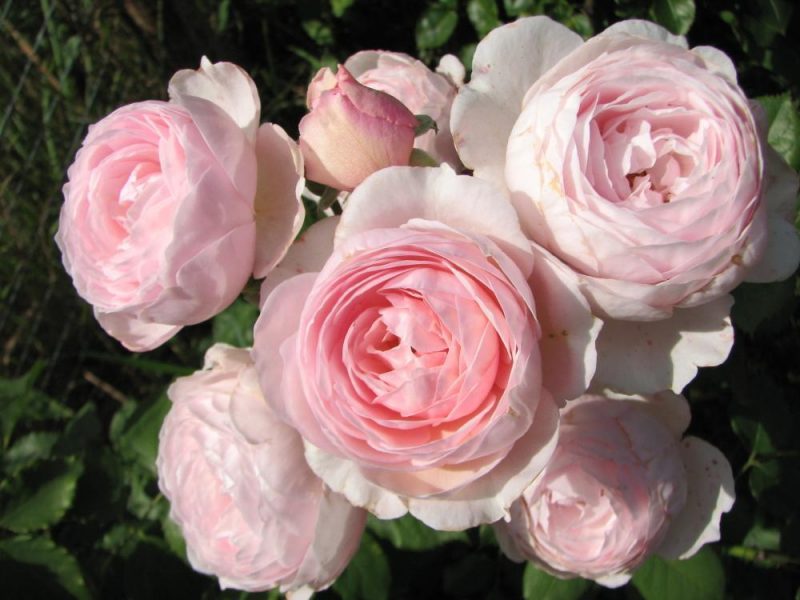
There are several vegetative methods - dividing the bush, cuttings, layering. But the varieties of a flower on a rosehip stock are propagated by grafting.
In the southern regions with mild winters, you can try cuttings, growing English roses, as root.
Plant diseases and pests
Scheduled treatments for diseases and pests throughout the year should be repeated. The first spraying is carried out immediately after removing the winter shelter. The second - before the buds open, and the last - in August.
Insecticides are used from aphids, leaf beetles and a sawfly sawfly. In the fight against spider mites, the drugs of the avermectin group are effective: Fitoverm, Vermitek and Aktofit.
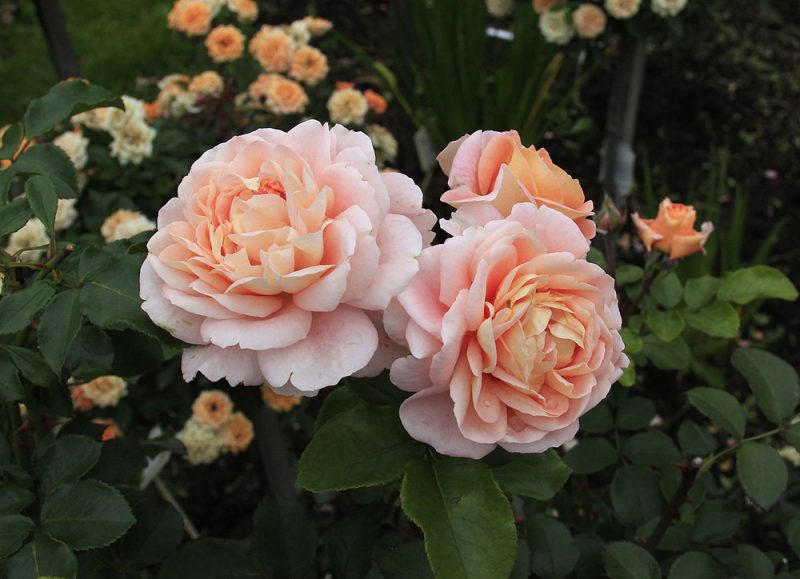
For the prevention and treatment of powdery mildew, roses are treated with fungicides - “Skor” or “Topaz”. In August, black spotting, septoria is activated. At the first signs of these diseases, the plants are sprayed with preparations containing the substance Mancozeb ("Profit", "Ridomil Gold").
Before sheltering roses for the winter, they are treated with Hom, Horus, Bordeaux mixture. A good drug for fungal diseases on roses is Abiga Peak, it has a universal purpose.
Autumn can not leave fallen leaves in the rose garden. It is necessary to well loosen the ground between the bushes, so that the spores of fungi freeze in the winter.
Technology of sheltering roses for the winter
Park rose, resistant to frost, was not used for breeding English varieties. All heat-loving species are planted on the rosehip stock, but they need shelter during the cold weather.
They begin to cover roses for the winter when the temperature is -5 ° C. These plants are not afraid of a small cold. When the cooling becomes stable, begin to create a winter shelter.
If you hurry up and cover the roses too soon, they can vypryat. Shelter should be done in dry weather. It is advisable that a few days before this there is no rain.
Before sheltering, young shoots, leaves, flowers and buds are removed on the bushes. If shoots are pruned, all sections are treated with garden varieties or Runet. Then they bend the roses to the ground, attaching metal studs.
Prepared roses are covered with fir branches or coniferous litter. Double spanbond is laid on top. On the edges of the material is pinned or pressed with stones.
When the air temperature is still not too low, it is advisable to leave one end of the spunbond open so that air enters the roses. Plants are completely hermetically sealed when the air temperature becomes -10 ° C. It is undesirable to use film for shelter.
Use in landscape design
English roses of David Austin have a pion-shaped flower. They can be used in classic flower beds with boxwood. Long shoots will drop on the bushes, as on a support, pleasing to the eye.
It is advisable to make the rose garden stepwise, planting in front those varieties that are lower, then tall. Curly roses are placed in the background.
Different varieties combine well in one rose garden. A feature of English roses are large flowers that cannot hold high on flexible shoots and slightly wilt. The output will be bamboo sticks for garter and good mineral fertilizing, which contribute to the strengthening of shoots.


